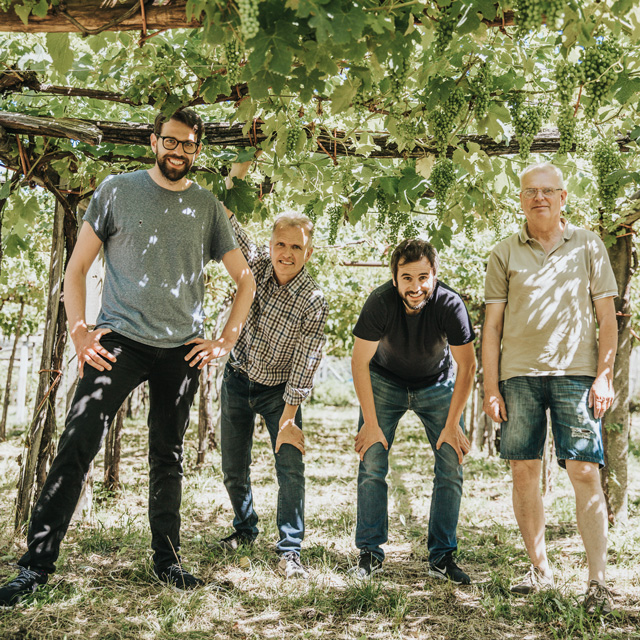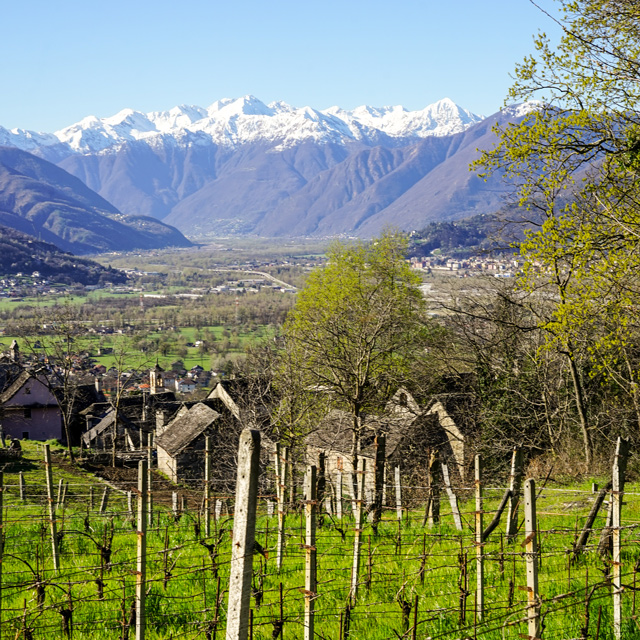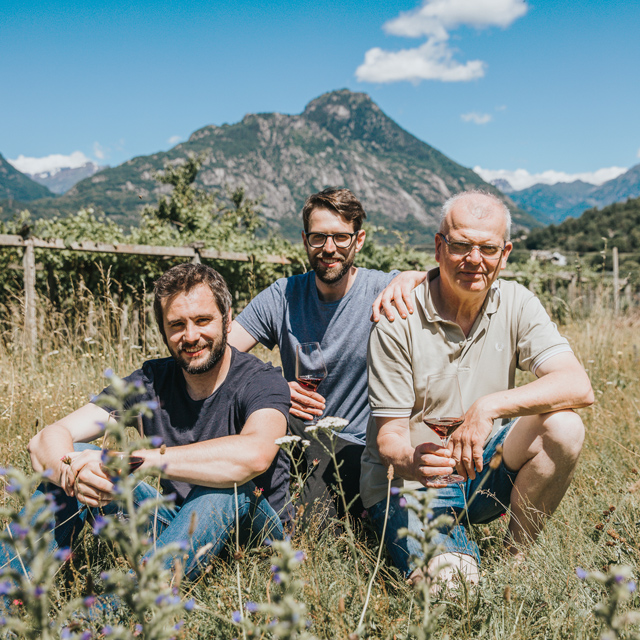Notify me
2023 Vino Rosso “Munaloss”
Cantine Garrone

The Garrone family under vines trained in the region’s distinctive toppia method

The view from Cantine Garrone’s vines

Back in May, when we shared the Prünent—aka Nebbiolo—revelations of Cantine Garrone with you, we had low stock of the family’s Munaloss bottling, an extraordinary value, so I mentioned it briefly in passing while focusing more on the majestic, single-variety wines that go toe to toe with the best of Barolo. But a small shipment of the Munaloss just arrived at the port a few days ago, so I feel like I can now properly give this $19 beautiful Nebbiolo blend its due.
Near Italy’s border with Switzerland, Piemonte’s Val d’Ossola can feel remote in a geographical sense, but also a temporal one. Being there, you might think you’ve traveled back in time several hundred years. Largely untouched places like this sometimes produce delicious but rustic wines, but in Cantine Garrone’s case, the wines are delicious and extraordinarily refined. This finesse comes, in part, from the region’s cool climate and also from its distinctive toppia system, wherein vines are trained on massive stone and wooden pergolas to ensure slow ripening and as much protection from the elements as possible.
A beautiful introduction to the Garrones’ line-up, blending mostly Nebbiolo with a splash of Croatina, Munaloss is fresh and juicy, with notes of cherries and brambly fruit. It is a perfect red for pizza on the patio, seared tuna with tomatoes and capers, or your favorite weeknight pasta.
—Tom Wolf
| Wine Type: | red |
| Vintage: | 2023 |
| Bottle Size: | 750mL |
| Blend: | 80% Prünent (Nebbiolo), 20% Croatina |
| Country: | Italy |
| Region: | Piedmont |
| Producer: | Cantine Garrone |
| Winemaker: | Piermario, Roberto, Marco and Matteo Garrone |
| Vineyard: | 10-50 years old; 4.5 ha |
| Soil: | Sandy loam, gneiss |
| Farming: | Sustainable |
| Alcohol: | 12.5% |
More from this Producer or Region

2020 Barolo “Le Coste di Monforte”
Italy | Piedmont
While charming now, Le Coste di Monforte will reward you for many years to come.

2022 Valli Ossolane Nebbiolo Superiore “Prünent”
Italy | Piedmont
This smooth and noble wine has the depth and structure to pair with venison or other wild game while remaining immediately approachable. There are no rough edges!

2024 Barbera d’Alba “Vigna Santa Caterina”
Italy | Piedmont
For pasta night, it checks all the boxes: ripe berry fruit with cleansing acidity; richness contrasted by vivaciousness.

2021 Valli Ossolane Nebbiolo Superiore “Prünent Diecibrente”
Italy | Piedmont
Extraordinarily high-toned, silky, and graceful, this is the pinnacle of the family’s world-class Nebbioli.

2017 Barolo Bussia Riserva “Cascina Dardi”
Italy | Piedmont
Alessandro Fantino’s Riservas are as good as Barolo gets.

2020 Barolo “La Tartufaia” MAGNUM
Italy | Piedmont
The wines produced from La Tartufaia are textbook examples of classically structured Barolo typical of the area.

2022 Dolcetto di Diano d’Alba “Sörì Santa Lucia”
Italy | Piedmont
Real refreshment, plus a serious side and good concentration from old vines in chalky marl soils.

2022 Valli Ossolane Nebbiolo Superiore “Prünent Vigna Fornace”
Italy | Piedmont
Garrones’ first vintage from the historic site of La Fornace shows plenty of age-worthy structure, density, and ripe notes of cherry, plum, and leather.

2023 Erbaluce di Caluso “Tredicimesi”
Italy | Piedmont
Both generous and chiseled, it evokes orchard fruit, citrus, and has an irresistibly saline finish.

2024 Langhe Arneis
Italy | Piedmont
December Club Gourmand ~ This dreamy wine reaffirms that we should turn more often to Piedmont not only for our reds but also for our whites!
About The Producer
Cantine Garrone
Cantine Garrone was founded in 1921 by Luigi Garrone in Piemonte’s northernmost wine appellation, Val d’Ossola. Even now, this is one of the most wild and inaccessible parts of Piemonte, where many of the vines cling to mountainsides at incredibly steep inclines. Today, Luigi’s grandsons, Piermario and Roberto, run the winery alongside Roberto’s two sons, Marco and Matteo. The family has made it their life’s purpose to preserve and elevate the wines of Val d’Ossola, focusing in particular on Prünent, commonly understood to be the oldest existing clone of Nebbiolo. In the 1990s, they launched an effort to assist local farmers who were struggling to produce enough grapes for any viable commercial activity. They work with more than forty growers to combine their efforts and as a result, have saved the local winemaking tradition from certain extinction. In total, the family owns 3.5 hectares of vineyard and manages another 7.5 through this community of forty growers.
About The Region
Piedmont

Kermit’s love affair with the great reds of Piemonte dates back to the early days of his career: the very first container he imported from Italy, in fact, featured legendary 1971 and 1974 Barolos from Vietti and Aldo Conterno. Regular visits since then have seen our portfolio grow to now twelve Piemontesi estates, with a strong focus on the rolling hills of the Langhe.
Nebbiolo rules these majestic, vine-covered marl slopes, giving Italy’s most mystifyingly complex, nuanced, and age-worthy reds. When crafted via traditional production methods—long macerations and extensive aging in enormous oak botti—the powerful, yet incredibly refined Barolos and Barbarescos provide haunting aromatics of tar, raspberry, incense, tea, roses, and more. At times austere in their youth but well worth the wait, they pair beautifully with the hearty local cuisine starring veal in many forms, braised beef, pastas like tajarin and agnolotti, and of course, Alba’s famous white truffles.
Surrounded by mountains on three sides, Piemonte’s climate is continental, with baking hot summers and cold winters. Nebbiolo is only part of the story here: juicy, fruity Barberas and Dolcettos represent the bread and butter throughout the region, and other native grapes like Freisa, Croatina, and the white Arneis are also noteworthy. Value abounds in the Monferrato, while Alto Piemonte also has its share of thrills to provide.
Every corner of Piemonte is rich with tradition, especially when wine is concerned. It’s no wonder we have been singing the region’s praises for over forty years.
More from Piedmont or Italy
“Ross da Travaj” Vermouth
Bèrto Italy | Piedmont
2024 Barbera d’Alba “Vigna Santa Caterina”
Guido Porro Italy | Piedmont
2021 Barolo “Marassio”
Giulia Negri Italy | Piedmont
2021 Barolo “Gianetto”
Guido Porro Italy | Piedmont
2023 Erbaluce di Caluso “Le Chiusure”
Cantina Favaro Italy | Piedmont
2022 Barbaresco “Vicenziana”
Silvio Giamello Italy | Piedmont
2021 Valli Ossolane Nebbiolo Superiore “Prünent Diecibrente”
Cantine Garrone Italy | Piedmont
2021 Barolo “La Tartufaia”
Giulia Negri Italy | Piedmont
2024 Langhe Nebbiolo
Piero Benevelli Italy | Piedmont
2020 Barolo “La Tartufaia” MAGNUM
Giulia Negri Italy | Piedmont
2024 Dolcetto d’Alba “La Costa”
Piero Benevelli Italy | Piedmont
2022 Dolcetto di Diano d’Alba “Sörì Cristina”
Il Palazzotto Italy | Piedmont
“Ross da Travaj” Vermouth
Bèrto Italy | Piedmont
2024 Barbera d’Alba “Vigna Santa Caterina”
Guido Porro Italy | Piedmont
2021 Barolo “Marassio”
Giulia Negri Italy | Piedmont
2021 Barolo “Gianetto”
Guido Porro Italy | Piedmont
2023 Erbaluce di Caluso “Le Chiusure”
Cantina Favaro Italy | Piedmont
2022 Barbaresco “Vicenziana”
Silvio Giamello Italy | Piedmont
2021 Valli Ossolane Nebbiolo Superiore “Prünent Diecibrente”
Cantine Garrone Italy | Piedmont
2021 Barolo “La Tartufaia”
Giulia Negri Italy | Piedmont
2024 Langhe Nebbiolo
Piero Benevelli Italy | Piedmont
2020 Barolo “La Tartufaia” MAGNUM
Giulia Negri Italy | Piedmont
2024 Dolcetto d’Alba “La Costa”
Piero Benevelli Italy | Piedmont
2022 Dolcetto di Diano d’Alba “Sörì Cristina”
Il Palazzotto Italy | Piedmont
Kermit once said...

Kermit once said...
When buying red Burgundy, I think we should remember:
1. Big wines do not age better than light wine.
2. A so-called great vintage at the outset does not guarantee a great vintage for the duration.
3. A so-called off vintage at the outset does not mean the wines do not have a brilliant future ahead of them.
4. Red Burgundy should not taste like Guigal Côte-Rôtie, even if most wine writers wish it would.
5. Don’t follow leaders; watch yer parking meters.
Inspiring Thirst, page 174




















